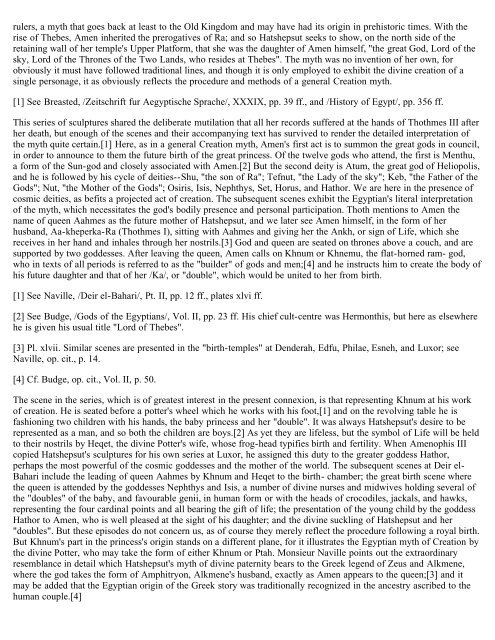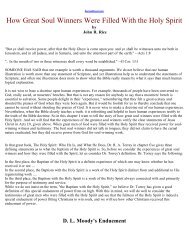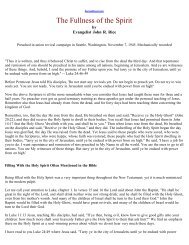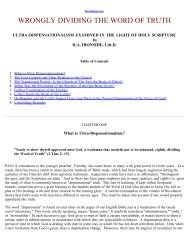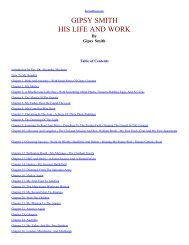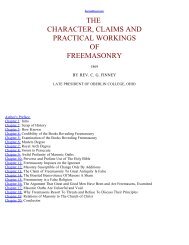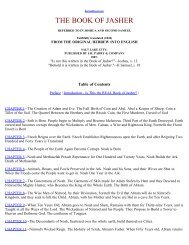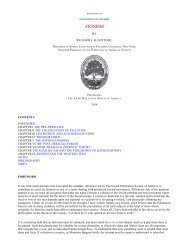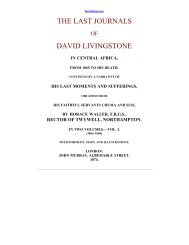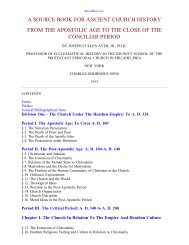Legends of Babylon and Egypt in Relation to Hebrew Tradition.pdf
Legends of Babylon and Egypt in Relation to Hebrew Tradition.pdf
Legends of Babylon and Egypt in Relation to Hebrew Tradition.pdf
You also want an ePaper? Increase the reach of your titles
YUMPU automatically turns print PDFs into web optimized ePapers that Google loves.
ulers, a myth that goes back at least <strong>to</strong> the Old K<strong>in</strong>gdom <strong>and</strong> may have had its orig<strong>in</strong> <strong>in</strong> prehis<strong>to</strong>ric times. With the<br />
rise <strong>of</strong> Thebes, Amen <strong>in</strong>herited the prerogatives <strong>of</strong> Ra; <strong>and</strong> so Hatshepsut seeks <strong>to</strong> show, on the north side <strong>of</strong> the<br />
reta<strong>in</strong><strong>in</strong>g wall <strong>of</strong> her temple's Upper Platform, that she was the daughter <strong>of</strong> Amen himself, "the great God, Lord <strong>of</strong> the<br />
sky, Lord <strong>of</strong> the Thrones <strong>of</strong> the Two L<strong>and</strong>s, who resides at Thebes". The myth was no <strong>in</strong>vention <strong>of</strong> her own, for<br />
obviously it must have followed traditional l<strong>in</strong>es, <strong>and</strong> though it is only employed <strong>to</strong> exhibit the div<strong>in</strong>e creation <strong>of</strong> a<br />
s<strong>in</strong>gle personage, it as obviously reflects the procedure <strong>and</strong> methods <strong>of</strong> a general Creation myth.<br />
[1] See Breasted, /Zeitschrift fur Aegyptische Sprache/, XXXIX, pp. 39 ff., <strong>and</strong> /His<strong>to</strong>ry <strong>of</strong> <strong>Egypt</strong>/, pp. 356 ff.<br />
This series <strong>of</strong> sculptures shared the deliberate mutilation that all her records suffered at the h<strong>and</strong>s <strong>of</strong> Thothmes III after<br />
her death, but enough <strong>of</strong> the scenes <strong>and</strong> their accompany<strong>in</strong>g text has survived <strong>to</strong> render the detailed <strong>in</strong>terpretation <strong>of</strong><br />
the myth quite certa<strong>in</strong>.[1] Here, as <strong>in</strong> a general Creation myth, Amen's first act is <strong>to</strong> summon the great gods <strong>in</strong> council,<br />
<strong>in</strong> order <strong>to</strong> announce <strong>to</strong> them the future birth <strong>of</strong> the great pr<strong>in</strong>cess. Of the twelve gods who attend, the first is Menthu,<br />
a form <strong>of</strong> the Sun-god <strong>and</strong> closely associated with Amen.[2] But the second deity is Atum, the great god <strong>of</strong> Heliopolis,<br />
<strong>and</strong> he is followed by his cycle <strong>of</strong> deities--Shu, "the son <strong>of</strong> Ra"; Tefnut, "the Lady <strong>of</strong> the sky"; Keb, "the Father <strong>of</strong> the<br />
Gods"; Nut, "the Mother <strong>of</strong> the Gods"; Osiris, Isis, Nephthys, Set, Horus, <strong>and</strong> Hathor. We are here <strong>in</strong> the presence <strong>of</strong><br />
cosmic deities, as befits a projected act <strong>of</strong> creation. The subsequent scenes exhibit the <strong>Egypt</strong>ian's literal <strong>in</strong>terpretation<br />
<strong>of</strong> the myth, which necessitates the god's bodily presence <strong>and</strong> personal participation. Thoth mentions <strong>to</strong> Amen the<br />
name <strong>of</strong> queen Aahmes as the future mother <strong>of</strong> Hatshepsut, <strong>and</strong> we later see Amen himself, <strong>in</strong> the form <strong>of</strong> her<br />
husb<strong>and</strong>, Aa-kheperka-Ra (Thothmes I), sitt<strong>in</strong>g with Aahmes <strong>and</strong> giv<strong>in</strong>g her the Ankh, or sign <strong>of</strong> Life, which she<br />
receives <strong>in</strong> her h<strong>and</strong> <strong>and</strong> <strong>in</strong>hales through her nostrils.[3] God <strong>and</strong> queen are seated on thrones above a couch, <strong>and</strong> are<br />
supported by two goddesses. After leav<strong>in</strong>g the queen, Amen calls on Khnum or Khnemu, the flat-horned ram- god,<br />
who <strong>in</strong> texts <strong>of</strong> all periods is referred <strong>to</strong> as the "builder" <strong>of</strong> gods <strong>and</strong> men;[4] <strong>and</strong> he <strong>in</strong>structs him <strong>to</strong> create the body <strong>of</strong><br />
his future daughter <strong>and</strong> that <strong>of</strong> her /Ka/, or "double", which would be united <strong>to</strong> her from birth.<br />
[1] See Naville, /Deir el-Bahari/, Pt. II, pp. 12 ff., plates xlvi ff.<br />
[2] See Budge, /Gods <strong>of</strong> the <strong>Egypt</strong>ians/, Vol. II, pp. 23 ff. His chief cult-centre was Hermonthis, but here as elsewhere<br />
he is given his usual title "Lord <strong>of</strong> Thebes".<br />
[3] Pl. xlvii. Similar scenes are presented <strong>in</strong> the "birth-temples" at Denderah, Edfu, Philae, Esneh, <strong>and</strong> Luxor; see<br />
Naville, op. cit., p. 14.<br />
[4] Cf. Budge, op. cit., Vol. II, p. 50.<br />
The scene <strong>in</strong> the series, which is <strong>of</strong> greatest <strong>in</strong>terest <strong>in</strong> the present connexion, is that represent<strong>in</strong>g Khnum at his work<br />
<strong>of</strong> creation. He is seated before a potter's wheel which he works with his foot,[1] <strong>and</strong> on the revolv<strong>in</strong>g table he is<br />
fashion<strong>in</strong>g two children with his h<strong>and</strong>s, the baby pr<strong>in</strong>cess <strong>and</strong> her "double". It was always Hatshepsut's desire <strong>to</strong> be<br />
represented as a man, <strong>and</strong> so both the children are boys.[2] As yet they are lifeless, but the symbol <strong>of</strong> Life will be held<br />
<strong>to</strong> their nostrils by Heqet, the div<strong>in</strong>e Potter's wife, whose frog-head typifies birth <strong>and</strong> fertility. When Amenophis III<br />
copied Hatshepsut's sculptures for his own series at Luxor, he assigned this duty <strong>to</strong> the greater goddess Hathor,<br />
perhaps the most powerful <strong>of</strong> the cosmic goddesses <strong>and</strong> the mother <strong>of</strong> the world. The subsequent scenes at Deir el-<br />
Bahari <strong>in</strong>clude the lead<strong>in</strong>g <strong>of</strong> queen Aahmes by Khnum <strong>and</strong> Heqet <strong>to</strong> the birth- chamber; the great birth scene where<br />
the queen is attended by the goddesses Nephthys <strong>and</strong> Isis, a number <strong>of</strong> div<strong>in</strong>e nurses <strong>and</strong> midwives hold<strong>in</strong>g several <strong>of</strong><br />
the "doubles" <strong>of</strong> the baby, <strong>and</strong> favourable genii, <strong>in</strong> human form or with the heads <strong>of</strong> crocodiles, jackals, <strong>and</strong> hawks,<br />
represent<strong>in</strong>g the four card<strong>in</strong>al po<strong>in</strong>ts <strong>and</strong> all bear<strong>in</strong>g the gift <strong>of</strong> life; the presentation <strong>of</strong> the young child by the goddess<br />
Hathor <strong>to</strong> Amen, who is well pleased at the sight <strong>of</strong> his daughter; <strong>and</strong> the div<strong>in</strong>e suckl<strong>in</strong>g <strong>of</strong> Hatshepsut <strong>and</strong> her<br />
"doubles". But these episodes do not concern us, as <strong>of</strong> course they merely reflect the procedure follow<strong>in</strong>g a royal birth.<br />
But Khnum's part <strong>in</strong> the pr<strong>in</strong>cess's orig<strong>in</strong> st<strong>and</strong>s on a different plane, for it illustrates the <strong>Egypt</strong>ian myth <strong>of</strong> Creation by<br />
the div<strong>in</strong>e Potter, who may take the form <strong>of</strong> either Khnum or Ptah. Monsieur Naville po<strong>in</strong>ts out the extraord<strong>in</strong>ary<br />
resemblance <strong>in</strong> detail which Hatshepsut's myth <strong>of</strong> div<strong>in</strong>e paternity bears <strong>to</strong> the Greek legend <strong>of</strong> Zeus <strong>and</strong> Alkmene,<br />
where the god takes the form <strong>of</strong> Amphitryon, Alkmene's husb<strong>and</strong>, exactly as Amen appears <strong>to</strong> the queen;[3] <strong>and</strong> it<br />
may be added that the <strong>Egypt</strong>ian orig<strong>in</strong> <strong>of</strong> the Greek s<strong>to</strong>ry was traditionally recognized <strong>in</strong> the ancestry ascribed <strong>to</strong> the<br />
human couple.[4]


